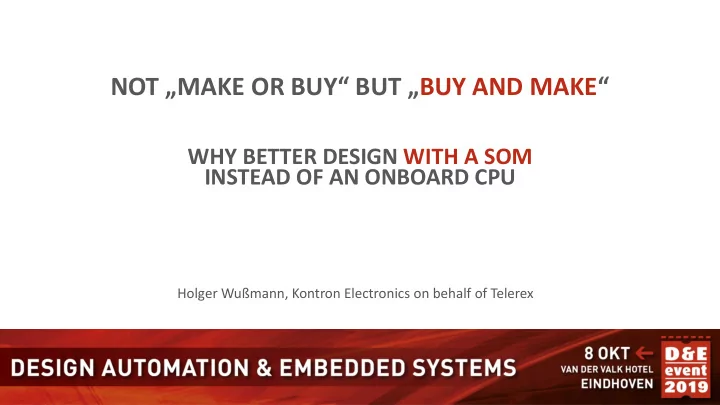

NOT „MAKE OR BUY“ BUT „ BUY AND MAKE “ WHY BETTER DESIGN WITH A SOM INSTEAD OF AN ONBOARD CPU Holger Wußmann, Kontron Electronics on behalf of Telerex 1
2
THE MAGIC TRIANGLE OF PROJECT-/PRODUCTMANAGEMENT Little money Few staff Low risk Short time Defined feature set Defined level of quality
MAIN GAOLS FOR A „ GOOD “ DEVELOPER OR PRODUCT MANAGER • Reduce effort (time and money) • Reduce risk • Reduce complexity • Be fast • Be flexible an prepared for future requirements (New Displays, Connectivity, IoT, …) • Be focused on your USP, your companies know how
LOOKING LIKE TWINS: SOM+BASEBOARD VERSUS SINGLE BOARD COMPUTER 5
A SOM IN A NUTSHELL Complete Core Hardware and Software µP, GPU, Memory, Power supply, communication interfaces, GPIO Ready to use Software (SDK, Bootloader, OS, BSP, Drivers…) Independant of application Usable for the development of almost any product Combination of standardized SOM and application specific carrier board is a perfect platform for various embedded products 6
WHY DO WE HAVE SOMS NOWADAYS? Rapidly increasing requirements for small, powerful embedded systems (due to progressive digitization) First integration by semiconductor manufacturer in the form of SOCs Second integration by electronics manufacturer in the form of SOMs High number of connections on small space Critical Timings High quantity High quality 7
STRATEGIC ASPECTS Ready developed core module. Shorter time to market Less design risk due to well-tried solution Long term available CPU module Lifecylce management by manufacturer A CPU core optimized in every aspect Open X (Open Source, Open Hardware, Open Software) 8
SCHEMATIC DESIGN ASPECTS Complex CPU Core is a ready developed module. Usable as easy as a microcontroller CPU Setup / Multiplexing Power supply (Power up/down sequencing) Memory design (DDR3/DDR4…) Baseboard is application optimized Exactly the required featureset, no overhead, design is BOM optimized In-house standard connectors It‘s your IP, it‘s your product 9
LAYOUT DESIGN ASPECTS You can use a ready developed module. Complex DDR3/DDR4 RAM design is done Length adjustments, Signal delay adjustments, RAM-Timing High frequency design needed, optional simulation needed Space needed for CPU core is defined right from the beginning EMC is already checked decoupling capacitors are placed (in right number and right position) Impedance controlled lines are designed Placement according to evironmental requirements 10
TECHNOLOGICAL ASPECTS Separation of normal and ultra-fine conductor structures (on baseboard and SOM) Separation of very small parts (0201) and bigger parts with thermal or mechanical requirements (production machines / pcb requirements) Mechanical decoupling of sensitive components from stressed components (BGAs separated from connectors and sockets) 11
TESTING ASPECTS SOM can be tested individually SOM can be tested deeper and more intelligent in terms of accessable testing points Significant less testpoints needed on baseboard (lower cost for adapter) SOM can come preconfigured (Bootloader, OS, application, MAC address) Testing by a robot (fewer human errors) 12
HMI ASPECTS Generic graphics interfaces on SOM Converter to individual display on baseboard Family adapter concept Drivers and adaption for mainstream and individual displays GUI via QT Optimized Browser for Webterminal functionality 13
SOFTWARE ASPECTS Bootloader (Uboot) Linux BSP (Yocto based) Programming in C IEC 61131-3 PLC programming (CODESYS) GUI via QT Optimized Browser for Webterminal functionality Individual Software Support for individual components / drivers 14
COST ASPECTS Separation of the (small) 8 to 10 layer SOM and the (larger) 4 to 6 layer baseboard (lower PCB cost) Separation of normal and ultra-fine conductor structures (lower PCB cost, higher availability of PCB manufacturers) SOM cost optimized Benefit from higher quantities Baseboard BOM optimized SOM product maintenance free of charge 15
STANDARDIZATION OSM Standardization procedure startet in SGET 4 form factors: zero, small, medium, large 30x13,5; 30x30; 30x48; 48x48 (mm) Predefined pining 147 pins, 267 pins, 395 pins, 593 pins (LGA) Broad range of manufacturers interested 16
SUMMARY OF ASPECTS Designing a system based on a modern, complex CPU is not a simple thing. Concentrate on your USP: The scope and the features of your product are your USP. The features, the functionality, the interfaces are placed on the baseboard. You get the schematic and the BOM of reference board (Open source hardware). You get the Linux BSP (Open source software). You can get design support (Review of schematic and layout). 17
UNLIMITED POSSIBILITIES 18
#askTELEREX #thankyouforlistening
Recommend
More recommend